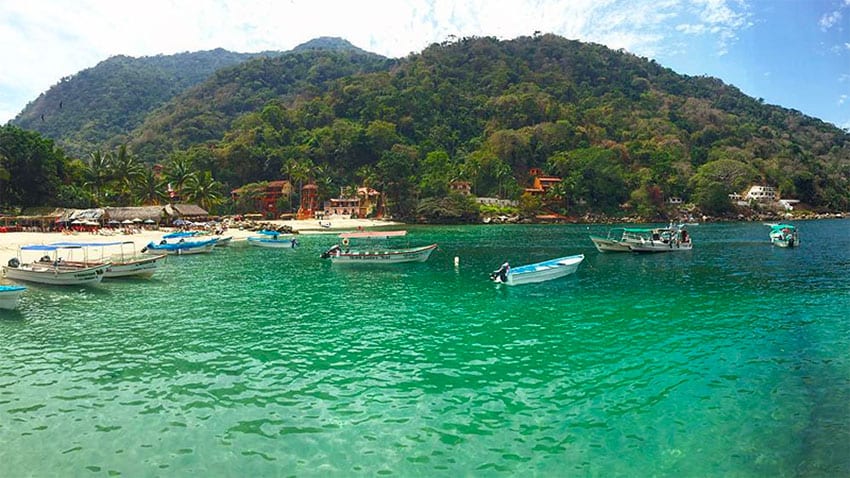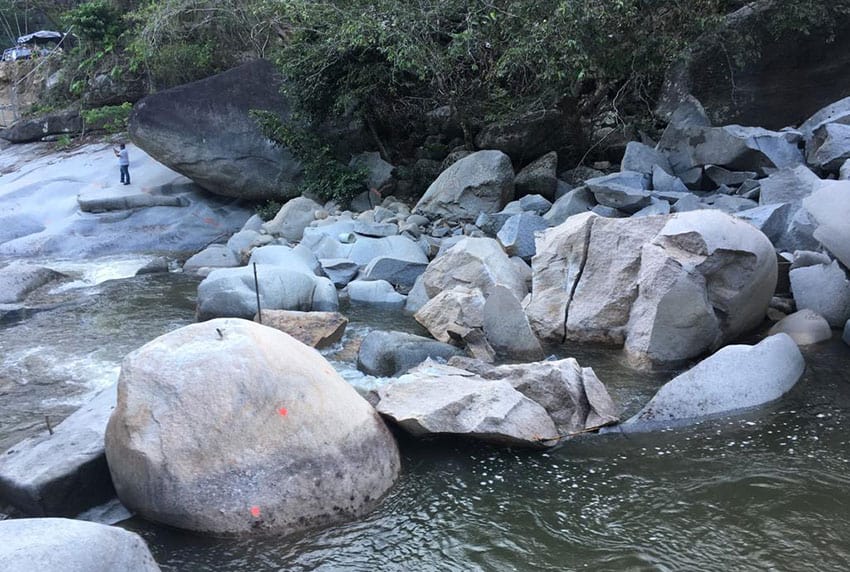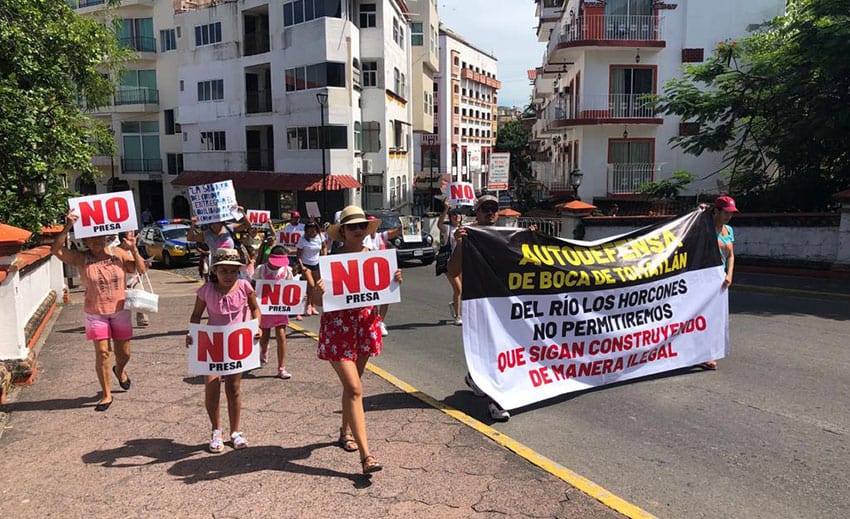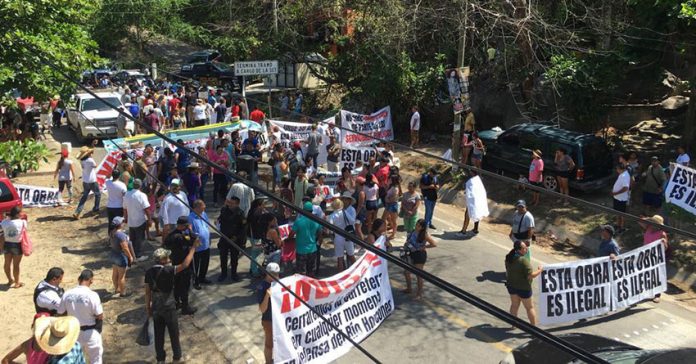A hydroelectric dam project that will allegedly divert one of Puerto Vallarta’s last pure rivers leading from the sierra to the ocean is not only illegal and unethical, local residents say, but reeks of high-level corruption and threatens to further endanger protected flora and fauna in the region.
Residents of Boca de Tomatlán and areas surrounding the Los Horcones river say they were surprised when about a dozen workers appeared with excavating equipment and dynamite in January, about 40 minutes south of Old Town Puerto Vallarta.
The river is part of a canyon ecosystem where jaguars, river otters, macaws and rare orchids remain in their natural habitat, surviving at the border of encroaching sprawl from Puerto Vallarta’s tourism and real estate developments.
“My concern is that the Los Horcones riverbed has been untouched by humans for years,” said Mario Morga, resident of Boca de Tomatlán and president of a local defense committee. He claimed that the damming of the river is directly related to a local resort, Garza Blanca, which intends to expand its property and the number of inhabitants and tourists.
“The mini-hydroelectric plant intends to make a dam and pipe out as much as 60% of the water from the natural tributary from 2,200 meters above the riverbed, thus modifying the natural environment in a drastic way, and this is the place of thousands of species of flora and fauna, some of them protected by law,” Morga said.

“The residents of the town of Boca of Tomatlán depend directly on the water provided by the Los Horcones river for daily use . . . . It has been maintained as a sustainable tourist area and would turn into an industrial development with this type of work.”
A bilingual petition on Change.org to declare the canyon a protected area has gathered more than 434,700 signatures, edging close to a goal to obtain 500,000, at which point organizers plan to request a meeting with federal Environment Secretary Victor Toledo Manzur regarding federal protection of the area.
Six protests against the damming of the river have been held, two in downtown Puerto Vallarta and four in Boca de Tomatlán, where the Horcones river empties into the sea, about five kilometers downstream from the dam.
While the purpose of the hydroelectric dam has not been officially divulged, some observers suspect it is for the benefit of Garza Blanca Preserve Resort & Spa on Highway 200, about 15 kilometers south of Puerto Vallarta’s city center.
Carlos Bonilla, a biologist and researcher at the National Polytechnic University, said that due to deep secrecy surrounding the permits and construction, it has been difficult to officially tie Garza Blanca to the dam project and more difficult still to show proof of corruption between city governments, the dam builders and the resort.
“It is common in Mexico, as is with this case, that certain resources such as water are appropriated by private companies, shielded as being ‘green projects,’ but completely pass over the rights of the population by obtaining commercial economic benefits,” Bonilla said. “The particular point of the project in Los Horcones is to unmask the lack of sustainability, the false presentation of a clean energy, self-supplying project as one that does not take into account cultural conservation of the area, be it the environmental or the natural risks already identified by specialists.”

He mentions, as does Morga, that what initially alarmed the nearby communities is that they had not been consulted about the project, and that some of the dam construction is taking place on private property.
“They were trying to build a dam without consulting any member of Boca de Tomatlán and the company processed all the permits at the federal and municipal levels without us being considered,” said Morga, a Puerto Vallarta native who has lived in Boca de Tomatlán for more 23 years and guides tours in Bahía de Banderas.
“This type of work requires a public consultation, as well as being able to show that an environmental impact test has been conducted and that correct permits have been obtained legally. As far as we know, none of this exists.”
The dam project was temporarily shut down on July 19 on orders from Puerto Vallarta’s office of Urban Development and Environment for not having the required permits. The action was taken the Committee of Defenders of the Los Horcones river had presented information questioning the validity of permits obtained by the company, Grupo Hidrogenerador de Occidente, after Morga says it was proved that the work was being conducted within Puerto Vallarta on permits authorized by the neighboring municipality of Cabo Corrientes.
The companies associated with the dam have released statements insisting that the project will not cause any damage to the river or the surrounding jungle areas.
In August, Bonilla met with officials at the environmental protection agency, Profepa. “We have been able to get the authorities to listen to us and we look forward to the results of their analysis,” he said.

There were other concerns raised earlier this year when the resort allegedly cut down thousands of trees and relocated about one kilometer of Highway 200, after being given permission by the federal Transportation Secretariat. Local officials were unable to intervene in the matter, which reportedly limited public access to the beach.
Former Puerto Vallarta mayor and CEO of the Garza Blanca resort, Fernando González Corona, has said that the area that was logged will be reforested.
Repeated attempts to contact Garza Blanca, Grupo Hidrogenerador de Occidente and municipal officials in Puerto Vallarta were unsuccessful.
Sources speaking on condition of anonymity due to concerns for their personal safety have reported being intimidated by representatives of the companies involved, and noted that work on the dam project has taken place even during the shutdown that was ordered.
Individuals who have tourism-based businesses around the Horcones river allege that the dam is a threat to their businesses. Some area residents have expressed concern that property values could plummet as the region’s eco-tourism assets, such as the river and the surrounding jungle, are endangered.
The concern about the Los Horcones river has attracted attention because it is representative of greater water shortage concerns throughout the Puerto Vallarta region and beyond, said hydrologist José Antonio Gómez Reyna.
“Puerto Vallarta is facing a critical situation; there is no water left,” said Gómez, professor at the University of Guadalajara. “What will we do without water? They started to build at a fast pace: homes, hotels, condominium complexes, the airport, military bases, etc. The problem now is how much water these people need and require. First, we have to consider how many inhabitants Puerto Vallarta has.
“Secondly, we have to consider how many people are visiting because now we see that tourism is using a lot of water. This is another point: how are we treating the wastewater from the hotels and where is it going and in what quality is it being released?”
Gómez asserts that many of the aquifers in the region have been depleted, and that the rivers that used to provide water are doing so less and less now as climate change is resulting in less rain each year.
“The Los Horcones river is an important river here in the Sierra Madre Occidental, with endemic fauna and flora, it has a privileged position in terms of climate conditions, altitude and rain,” Gómez said. “The exchange of saltwater and freshwater is very important for the life of plankton, which is consumed by a number of marine animals at the mouth of the river. Therefore it’s very important that the rivers in these areas are not altered. Given that there are no population areas above the river and no potential for pollution, clean water runs into the surrounding area and into the sea.”
